Entry Database : PDB / ID : 1shwTitle EphB2 / EphrinA5 Complex Structure Ephrin type-B receptor 2 Ephrin-A5 Keywords / / / Function / homology Function Domain/homology Component
/ / / / / / / / / / / / / / / / / / / / / / / / / / / / / / / / / / / / / / / / / / / / / / / / / / / / / / / / / / / / / / / / / / / / / / / / / / / / / / / / / / / / / / / / / / / / / / / / / / / / / / / / / / / / / / / / / / / / / / / / / / / / / / / / / / / / / / / / / / / / / / / / / / / / / / / / / / / / / / / / / / / / / / / / Biological species Mus musculus (house mouse)Method / / / Resolution : 2.2 Å Authors Himanen, J.P. / Chumley, M.J. / Lackmann, M. / Li, C. / Barton, W.A. / Jeffrey, P.D. / Vearing, C. / Geleick, D. / Feldheim, D.A. / Boyd, A.W. Journal : Nat.Neurosci. / Year : 2004Title : Repelling class discrimination: ephrin-A5 binds to and activates EphB2 receptor signalingAuthors : Himanen, J.P. / Chumley, M.J. / Lackmann, M. / Li, C. / Barton, W.A. / Jeffrey, P.D. / Vearing, C. / Geleick, D. / Feldheim, D.A. / Boyd, A.W. / Henkemeyer, M. / Nikolov, D.B. History Deposition Feb 26, 2004 Deposition site / Processing site Revision 1.0 May 18, 2004 Provider / Type Revision 1.1 Apr 29, 2008 Group Revision 1.2 Jul 13, 2011 Group / Version format complianceRevision 2.0 Jul 29, 2020 Group Advisory / Atomic model ... Advisory / Atomic model / Data collection / Derived calculations / Structure summary Category atom_site / chem_comp ... atom_site / chem_comp / entity / entity_name_com / pdbx_branch_scheme / pdbx_chem_comp_identifier / pdbx_entity_branch / pdbx_entity_branch_descriptor / pdbx_entity_branch_link / pdbx_entity_branch_list / pdbx_entity_nonpoly / pdbx_molecule_features / pdbx_nonpoly_scheme / pdbx_struct_assembly_gen / pdbx_struct_conn_angle / pdbx_unobs_or_zero_occ_residues / struct_asym / struct_conn / struct_site / struct_site_gen Item _atom_site.auth_asym_id / _atom_site.auth_seq_id ... _atom_site.auth_asym_id / _atom_site.auth_seq_id / _atom_site.label_asym_id / _chem_comp.name / _chem_comp.type / _entity.formula_weight / _entity.pdbx_description / _entity.pdbx_number_of_molecules / _entity.type / _pdbx_struct_assembly_gen.asym_id_list / _pdbx_struct_conn_angle.ptnr2_label_asym_id / _struct_conn.pdbx_leaving_atom_flag / _struct_conn.pdbx_role / _struct_conn.ptnr1_auth_asym_id / _struct_conn.ptnr1_auth_comp_id / _struct_conn.ptnr1_auth_seq_id / _struct_conn.ptnr1_label_asym_id / _struct_conn.ptnr1_label_atom_id / _struct_conn.ptnr1_label_comp_id / _struct_conn.ptnr1_label_seq_id / _struct_conn.ptnr1_symmetry / _struct_conn.ptnr2_auth_asym_id / _struct_conn.ptnr2_auth_comp_id / _struct_conn.ptnr2_auth_seq_id / _struct_conn.ptnr2_label_asym_id / _struct_conn.ptnr2_label_atom_id / _struct_conn.ptnr2_label_comp_id / _struct_conn.ptnr2_label_seq_id / _struct_conn.ptnr2_symmetry Description / Provider / Type Revision 2.1 Apr 3, 2024 Group Advisory / Data collection ... Advisory / Data collection / Database references / Refinement description / Structure summary Category chem_comp / chem_comp_atom ... chem_comp / chem_comp_atom / chem_comp_bond / database_2 / pdbx_initial_refinement_model / pdbx_unobs_or_zero_occ_residues Item / _database_2.pdbx_DOI / _database_2.pdbx_database_accession
Show all Show less
 Open data
Open data Basic information
Basic information Components
Components Keywords
Keywords receptor tyrosine kinase / ephrin signaling / hormone-growth factor-receptor COMPLEX
receptor tyrosine kinase / ephrin signaling / hormone-growth factor-receptor COMPLEX Function and homology information
Function and homology information postsynaptic membrane assembly /
postsynaptic membrane assembly /  urogenital system development / regulation of body fluid levels / optic nerve morphogenesis /
urogenital system development / regulation of body fluid levels / optic nerve morphogenesis /  tight junction assembly / neuron projection retraction / negative regulation of substrate adhesion-dependent cell spreading / axon guidance receptor activity /
tight junction assembly / neuron projection retraction / negative regulation of substrate adhesion-dependent cell spreading / axon guidance receptor activity /  central nervous system projection neuron axonogenesis / synaptic membrane adhesion /
central nervous system projection neuron axonogenesis / synaptic membrane adhesion /  regulation of cell-cell adhesion / negative regulation of axonogenesis / regulation of behavioral fear response / transmembrane-ephrin receptor activity / positive regulation of long-term neuronal synaptic plasticity / collateral sprouting /
regulation of cell-cell adhesion / negative regulation of axonogenesis / regulation of behavioral fear response / transmembrane-ephrin receptor activity / positive regulation of long-term neuronal synaptic plasticity / collateral sprouting /  regulation of autophagosome assembly / positive regulation of dendritic spine morphogenesis / cellular response to follicle-stimulating hormone stimulus / dendritic spine development / corpus callosum development / positive regulation of collateral sprouting / positive regulation of synaptic plasticity / camera-type eye morphogenesis / regulation of insulin secretion involved in cellular response to glucose stimulus /
regulation of autophagosome assembly / positive regulation of dendritic spine morphogenesis / cellular response to follicle-stimulating hormone stimulus / dendritic spine development / corpus callosum development / positive regulation of collateral sprouting / positive regulation of synaptic plasticity / camera-type eye morphogenesis / regulation of insulin secretion involved in cellular response to glucose stimulus /  regulation of filopodium assembly /
regulation of filopodium assembly /  ephrin receptor activity / negative regulation of Ras protein signal transduction / positive regulation of protein localization to cell surface /
ephrin receptor activity / negative regulation of Ras protein signal transduction / positive regulation of protein localization to cell surface /  chemorepellent activity / commissural neuron axon guidance / dendritic spine morphogenesis / negative regulation of cell adhesion / regulation of cell morphogenesis / retinal ganglion cell axon guidance / axonal fasciculation / positive regulation of synapse assembly / regulation of receptor signaling pathway via JAK-STAT /
chemorepellent activity / commissural neuron axon guidance / dendritic spine morphogenesis / negative regulation of cell adhesion / regulation of cell morphogenesis / retinal ganglion cell axon guidance / axonal fasciculation / positive regulation of synapse assembly / regulation of receptor signaling pathway via JAK-STAT /  regulation of synapse assembly / inner ear morphogenesis /
regulation of synapse assembly / inner ear morphogenesis /  regulation of focal adhesion assembly / regulation of neuronal synaptic plasticity /
regulation of focal adhesion assembly / regulation of neuronal synaptic plasticity /  regulation of axonogenesis / B cell activation /
regulation of axonogenesis / B cell activation /  regulation of GTPase activity / roof of mouth development /
regulation of GTPase activity / roof of mouth development /  regulation of blood coagulation / positive regulation of immunoglobulin production /
regulation of blood coagulation / positive regulation of immunoglobulin production /  basement membrane / GABA-ergic synapse / negative regulation of cytokine production involved in inflammatory response / ephrin receptor signaling pathway / regulation of microtubule cytoskeleton organization / positive regulation of B cell proliferation / cellular response to forskolin / hippocampal mossy fiber to CA3 synapse /
basement membrane / GABA-ergic synapse / negative regulation of cytokine production involved in inflammatory response / ephrin receptor signaling pathway / regulation of microtubule cytoskeleton organization / positive regulation of B cell proliferation / cellular response to forskolin / hippocampal mossy fiber to CA3 synapse /  ephrin receptor binding /
ephrin receptor binding /  axonogenesis / negative regulation of protein phosphorylation /
axonogenesis / negative regulation of protein phosphorylation /  learning / positive regulation of long-term synaptic potentiation /
learning / positive regulation of long-term synaptic potentiation /  caveola / cell periphery /
caveola / cell periphery /  axon guidance / regulation of actin cytoskeleton organization / positive regulation of protein localization to plasma membrane /
axon guidance / regulation of actin cytoskeleton organization / positive regulation of protein localization to plasma membrane /  adherens junction / animal organ morphogenesis / negative regulation of protein kinase activity / cell morphogenesis / negative regulation of ERK1 and ERK2 cascade /
adherens junction / animal organ morphogenesis / negative regulation of protein kinase activity / cell morphogenesis / negative regulation of ERK1 and ERK2 cascade /  receptor protein-tyrosine kinase / peptidyl-tyrosine phosphorylation / cellular response to amyloid-beta /
receptor protein-tyrosine kinase / peptidyl-tyrosine phosphorylation / cellular response to amyloid-beta /  cell surface receptor protein tyrosine kinase signaling pathway / positive regulation of peptidyl-tyrosine phosphorylation / positive regulation of tumor necrosis factor production /
cell surface receptor protein tyrosine kinase signaling pathway / positive regulation of peptidyl-tyrosine phosphorylation / positive regulation of tumor necrosis factor production /  signaling receptor activity /
signaling receptor activity /  presynaptic membrane /
presynaptic membrane /  amyloid-beta binding /
amyloid-beta binding /  postsynaptic membrane / postsynapse /
postsynaptic membrane / postsynapse /  angiogenesis /
angiogenesis /  protein tyrosine kinase activity / cellular response to lipopolysaccharide /
protein tyrosine kinase activity / cellular response to lipopolysaccharide /  dendritic spine / learning or memory / positive regulation of cell migration
dendritic spine / learning or memory / positive regulation of cell migration
 Mus musculus (house mouse)
Mus musculus (house mouse) X-RAY DIFFRACTION /
X-RAY DIFFRACTION /  SYNCHROTRON /
SYNCHROTRON /  MOLECULAR REPLACEMENT / Resolution: 2.2 Å
MOLECULAR REPLACEMENT / Resolution: 2.2 Å  Authors
Authors Citation
Citation Journal: Nat.Neurosci. / Year: 2004
Journal: Nat.Neurosci. / Year: 2004 Structure visualization
Structure visualization Molmil
Molmil Jmol/JSmol
Jmol/JSmol Downloads & links
Downloads & links Download
Download 1shw.cif.gz
1shw.cif.gz PDBx/mmCIF format
PDBx/mmCIF format pdb1shw.ent.gz
pdb1shw.ent.gz PDB format
PDB format 1shw.json.gz
1shw.json.gz PDBx/mmJSON format
PDBx/mmJSON format Other downloads
Other downloads https://data.pdbj.org/pub/pdb/validation_reports/sh/1shw
https://data.pdbj.org/pub/pdb/validation_reports/sh/1shw ftp://data.pdbj.org/pub/pdb/validation_reports/sh/1shw
ftp://data.pdbj.org/pub/pdb/validation_reports/sh/1shw Links
Links Assembly
Assembly
 Components
Components Ephrin A5 / EPH-related receptor tyrosine kinase ligand 7 / LERK-7 / AL-1
Ephrin A5 / EPH-related receptor tyrosine kinase ligand 7 / LERK-7 / AL-1
 Mus musculus (house mouse) / Gene: EFNA5, EPLG7, LERK7, EPL7 / Cell line (production host): HEK293 / Production host:
Mus musculus (house mouse) / Gene: EFNA5, EPLG7, LERK7, EPL7 / Cell line (production host): HEK293 / Production host: 
 Homo sapiens (human) / References: UniProt: O08543
Homo sapiens (human) / References: UniProt: O08543
 Mus musculus (house mouse) / Gene: EPHB2, EPTH3, NUK, SEK3 / Plasmid: pET32 / Production host:
Mus musculus (house mouse) / Gene: EPHB2, EPTH3, NUK, SEK3 / Plasmid: pET32 / Production host: 
 Escherichia coli (E. coli) / Strain (production host): AD494 (DE3) / References: UniProt: P54763
Escherichia coli (E. coli) / Strain (production host): AD494 (DE3) / References: UniProt: P54763 Water
Water X-RAY DIFFRACTION / Number of used crystals: 1
X-RAY DIFFRACTION / Number of used crystals: 1  Sample preparation
Sample preparation
 SYNCHROTRON / Site:
SYNCHROTRON / Site:  NSLS
NSLS  / Beamline: X9A / Wavelength: 0.979 Å
/ Beamline: X9A / Wavelength: 0.979 Å : 0.979 Å / Relative weight: 1
: 0.979 Å / Relative weight: 1  Processing
Processing :
:  MOLECULAR REPLACEMENT
MOLECULAR REPLACEMENT Movie
Movie Controller
Controller




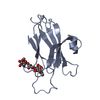
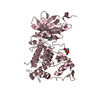

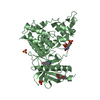
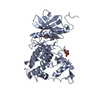
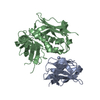



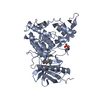
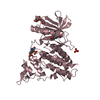
 PDBj
PDBj











